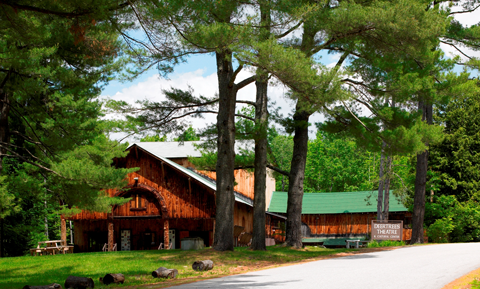 DEERTREES THEATER in Harrison |
Back in 1936, the theater architect Harold G. Wiseman build a rustic 350-seat Adirondack-style theater, with near perfect acoustics, in Harrison, Maine. Deertrees Theater, as it was christened—built as it was on a deer run—brought world-class actors and singers from New York to its stage. It went on to struggle financially, reinventing itself in various iterations, but today, almost eighty years after its construction and under the recent artistic direction of Andrew Harris, Deertrees is experiencing a revival. This summer, it presents a program that blends musical offerings—including the New Orleans jazz band The New Black Eagle Jazz band, the Emilia Dahlin Quartet, and several Celtic groups—with the production of three shows in a repertory program that’s already underway: David Butler’s The Grand O’Neal, Tom Stoppard’s translation and adaptation of Gérald Sibleyras’s Heroes, and an all-ages play by British playwright David Wood called The Selfish Shellfish.
Deertrees was the dreamchild of Enrica Clay Dillon, a director and dramatic coach who saw the theater as a non-commercial haven for “the beautiful, the truly real, for fine work and for unwavering ideals,” as she said in opening night remarks. While the first few seasons were devoted to her ideal of a “laboratory and experimental theater,” in 1939 she changed tacks, and her new producer Bela Blau brought a different Broadway cast to Harrison every week for more traditional, “straw-hat” summer fare; the stage saw such heavy-hitting stars as Ethyl Barrymore and Tallulah Bankhead. Her death in 1946 saw a dizzying progression of ownerships, theatrical programs, visions, and financial difficulties.
In 2011, Sawyer joined the board, became its Artistic Director, and took on the challenges of Deertrees’ debt, the maintenance of an aging theater, and an ever-evolving cultural economy. His hope, he says, is to pay homage to the many facets of the Deertrees heritage while ensuring that it is financially viable, culturally vital, and accessible to both local residents and visitors. Today, the theater includes the Deertrees New Repertory Company, the Sebago-Long Lake Music Festival, the Back-Stage Art Gallery, and the Salt Lick Café, in keeping with what Harris sees as the theater’s heritage of diverse entertainments. He also hopes to preserve the timelessness of the Deertrees aesthetic: “The real beauty of the place is that feel of being locked in time,” he says, “and it is crucial that is retained.”
 A HOUSE WITH GOOD BONES Deertrees actors David Butler, Paul Haley, and John Fogle in Heroes |
In his artistic direction of the theater program, Harris says, he has focused on local talent, rather than artists brought in from New York; to show three plays in repertory over the course of the summer, rather than in single four-night runs; and to present plays chosen for wide audience appeal. Sibleyras/Stoppard’s Heroes tells of three elderly British men who dream of escaping their veterans’ retirement hospital as a last adventure; Daniel Burson, who directs a production that stars David Butler, John Fogle, and Paul Haley, says that the show “captures the hope for something new and different on the horizon that we all feel sometimes.” The Grand O’Neal, written by local actor and writer David Butler, tells of another sort of adventure, the search for one’s ancestry, as a romantic American seeks his roots in Ireland. Finally, David Wood’s family show The Selfish Shellfish reveals the doings of tide-pool creatures, the havoc humans confer upon them, and the conservation practices that their healthy lives require of us.